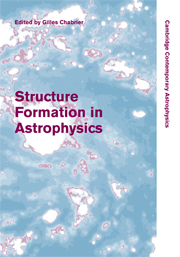Book contents
- Frontmatter
- Contents
- List of contributors
- Preface
- Part I Physical Processes and Numerical Methods Common to Structure Formations in Astrophysics
- Part II Structure and Star Formation in the Primordial Universe
- Part III Contemporary Star and Brown Dwarf Formation
- Part IV Protoplanetary Disks and Planet Formation
- 13 Observational properties of disks and young stellar objects
- 14 Structure and dynamics of protoplanetary disks
- 15 Planet formation and evolution: theory and observations
- 16 Planet formation: assembling the puzzle
- Part V Summary
16 - Planet formation: assembling the puzzle
Published online by Cambridge University Press: 11 August 2009
- Frontmatter
- Contents
- List of contributors
- Preface
- Part I Physical Processes and Numerical Methods Common to Structure Formations in Astrophysics
- Part II Structure and Star Formation in the Primordial Universe
- Part III Contemporary Star and Brown Dwarf Formation
- Part IV Protoplanetary Disks and Planet Formation
- 13 Observational properties of disks and young stellar objects
- 14 Structure and dynamics of protoplanetary disks
- 15 Planet formation and evolution: theory and observations
- 16 Planet formation: assembling the puzzle
- Part V Summary
Summary
Introduction
Although not precisely in its infancy, the question of building planets and planetary systems still faces many challenges: how are planetesimals assembled from micrometre-sized grains? What does radial transport do to growing dust aggregates? Do solids concentrate close to the star or do (metre size) objects vanish rapidly into the central star? How are planets formed from planetesimals? And how do giant planets form that have to acquire hydrogen and helium before the gas is accreted onto the star or is swept away by stellar winds and photoevaporation? Are many generations of planets formed and then lost? Can we explain the compositions of planets in the structure of our present solar system?
These are but a few of the basic questions which are currently the focus of a highly active research field. Presenting a complete overview of the problem is beyond the scope of this short chapter and would not be a long-lasting one as the field is rapidly evolving. We present here what we believe are some important pieces of the puzzle, in the domain of planetesimal formation and giant planet composition.
Planetesimals
There are several important steps of structure formation after the solar nebula formed and before full-size planets came into existence. One of them is the formation of planetesimals. There is some ambiguity in the term planetesimal as it is used throughout the literature.
- Type
- Chapter
- Information
- Structure Formation in Astrophysics , pp. 410 - 424Publisher: Cambridge University PressPrint publication year: 2009



